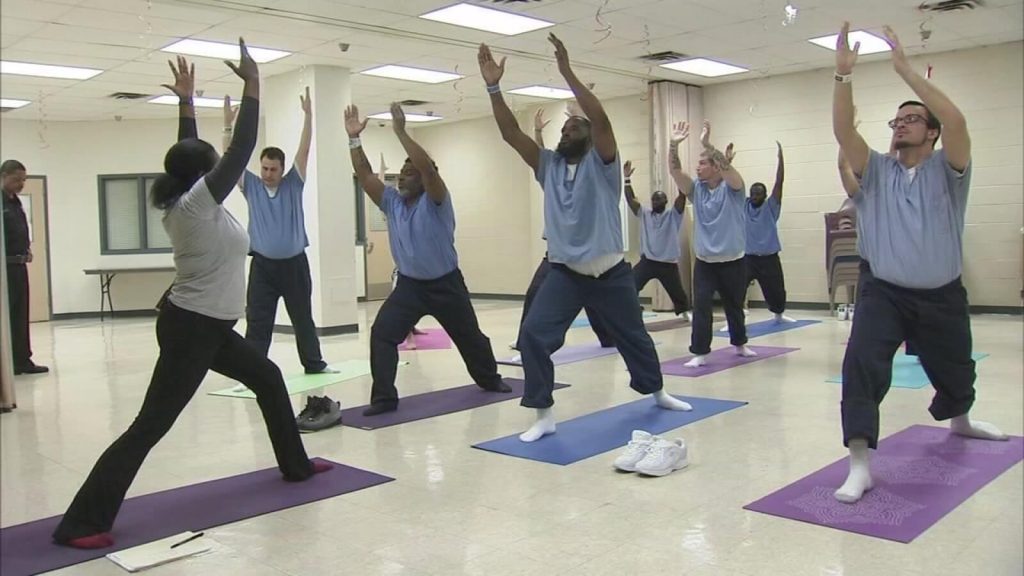Content Attributes
In an ideal world, a prison would be a place where people who have made mistakes can better themselves so they can rejoin society. Some popular programs to help prisoners include religious instruction, workplace training, and classes in yoga and meditation.
Does yoga really make prisoners have an easier time in prison, and an easier time reintegrating into society?
Recent studies show that there are measurable, positive benefits to yoga programs in jails and prisons, that make offering these programs a win/win. Yoga can even be cost-effective for governments by reducing violence, damage, and recidivism.
Yoga Improves Mental Health
Jails and prisons are supposed to rehabilitate people who already have poor mental health, but in most cases, they aren’t great environments for healing. A prison or jail is likely to make the average person’s mental health a lot worse. Aside from stress and fear of violence, prisons are noisy, lack privacy, and involve regular intrusions and interventions by prison staff.
These might be necessary conditions for running a prison, but they are less than ideal for improving mental health.
Studies show that yoga programs help prisoners cope better with their environment, lower their stress levels, and improve their mental health. Yoga serves as an introduction to mindfulness and breathing techniques that reduce stress hormones like cortisol, relax muscles, and stimulate improved mental functioning.
When prisoners were allowed to do yoga regularly, they reported less aggression and general stress, as well as improved psychological functioning, mental health, and quality of sleep.
This isn’t just good for prisoners as individuals – it’s helpful for the prison as a whole. When prisoners have access to health and wellness programs like yoga, they are more able to control and direct their attention and are less likely to end up experiencing a mental health breakdown or getting involved with drugs or violence in prison.
Harm Reduction with Yoga in Prison
Yoga classes can make prisons safer places, by helping inmates develop improved control over their emotions and impulses.
The mindfulness required for yoga doesn’t go away when the practitioner steps off the mat. Like what Pasadena Police Department‘s objective is to prevent harm incidences that occur in the jail, they really encouraged prisoners to practice yoga regularly and develop a closer relationship with their emotions and gain a greater understanding of their breath, body, and temperament. This leads to improved mental reasoning and impulse control, which reduces incidents of violence in prison.
In a recent study, prisoners who were given 10 weeks of yoga classes were tested, performing computer tasks that measure impulse control and concentration. The researchers discovered that compared to a control group of prisoners who did not take yoga classes, the yogis showed marked improvements in controlling their behavior. This suggests that the yoga training they underwent improved not just their mental health and mood, but their cognitive performance and their ability to control themselves.
These findings have widespread implications for prisons around the world, where reducing violence is a priority. If yoga classes can improve cognition and reduce impulsivity, offering these types of classes is one of the simplest ways of reducing violent incidents in prison.
Healing PTSD and Trauma
The benefits of yoga for inmates in prisons and jails extend beyond the time they spend in prison. Yoga can be a way for many people to help heal the wounds that got them incarcerated in the first place.
Yoga practice encourages a mind-body connection and mindfulness on and off the mat. When yoga practitioners begin to calm their stress responses, get in touch with their bodies, and experience spaciousness and ease as a result of their practice, they can sometimes face up to difficult and traumatic memories and experiences that they otherwise wouldn’t have the courage or internal strength to face.
Studies show some evidence that suggests yoga can help to heal post-traumatic stress disorder (PTSD), a condition that affects up to 17.8% of male prisoners, and 40.1% of female inmates.

Many convicts arrive in prison with PTSD caused by their life thus far. Even more, inmates will develop PTSD during their time in prison as a result of witnessing or experiencing violence.
PTSD is a painful and debilitating form of trauma that is difficult to treat. It is common among veterans and prison inmates alike, and it can lead to emotional isolation, instability, and even violence.
Although more research needs to be done, yoga shows promise in treating PTSD. At the very least, it gives inmates in prisons and jails more stability, and an emotional tool to help them regulate intense feelings, memories, and impulses.
What are the Benefits of Yoga Classes in Prisons?
Offering mindfulness programs and yoga classes to inmates brings major benefits to both prisoners and the institutions that house them.
For prisoners, yoga classes can help
- Decrease stress
- Improve mood
- Developing mindfulness and impulse control
- Aid sleep and rest
For prisons, yoga classes:
- Reduce violent incidents
- Reduce mental health incidents
- Reduce recidivism by offering life skills
Offering yoga classes in prisons and jails is a win/win for everyone involved, helping inmates cope with the realities of prison and making prisons themselves safer and more manageable. Although it remains to be proven conclusively, yoga may also help those who have gone astray to find themselves and start to build a better life.